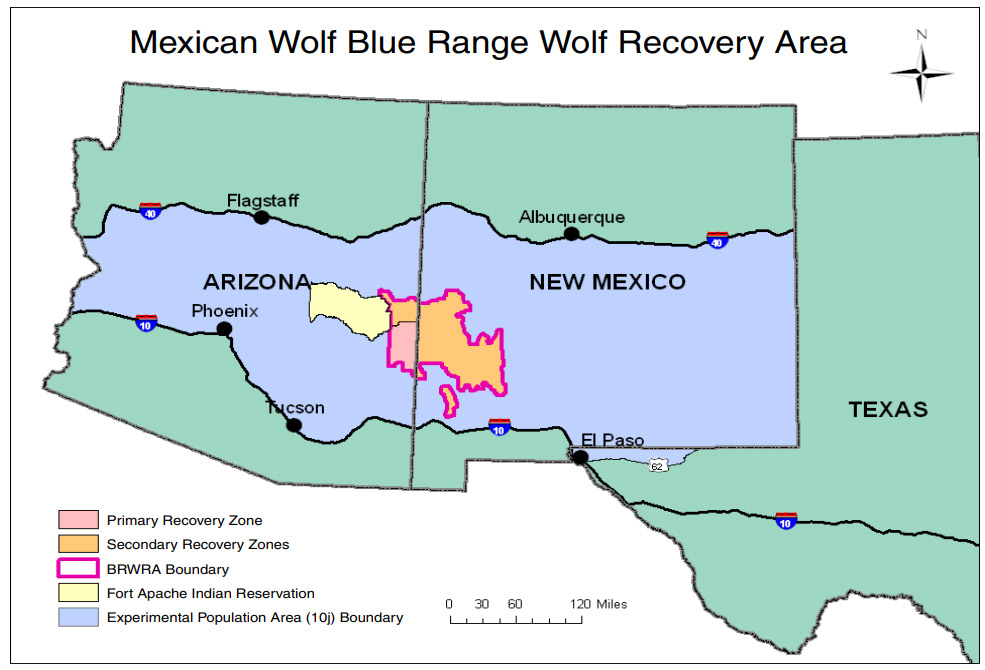
The Mexican gray wolf (Canis lupus baileyi), or “lobo,” is the smallest, southernmost occurring, rarest, and most genetically distinct subspecies of gray wolf in North America. It once occurred in the mountainous regions of the Southwest from central Mexico throughout portions of Texas, New Mexico, and Arizona, and perhaps even farther north, as suggested by more recent research. Aggressive predator control programs towards the turn of the century all but exterminated the Mexican wolf from the wild. With the capture of the last 5 remaining Mexican wolves in the wild in Mexico from 1977 – 1980, a captive-breeding program was initiated and saved the Mexican wolf from extinction. Today, the captive population consists of approximately 300 animals, and encompasses over 45 zoos and wildlife facilities throughout the United States and Mexico.
A typical Mexican wolf weighs between 50-80 pounds, is about 5 ½ feet in length including the tail (German Shepard size), stands approximately 28 – 32 inches at the shoulder, and has a richly-colored coat of buff, gray, rust, and black, often with distinguishing facial “masks.” Solid black or white variations do not exist as with other North American gray wolves. Like all wolves, Mexican wolves have a complex social structure and an intricate communication system that includes scent marking, body postures, and numerous vocalizations such as howling, barking, whining, and growling. They live in extended family groups, or packs, consisting of an adult mated pair and their offspring, often from several generations. Known prey for Mexican wolves includes elk, mule deer, and white-tailed deer, but wolves can and do occasionally kill livestock, especially young calves.
Recovery efforts for the Mexican wolf began when it was listed as endangered in1976. A Mexican wolf recovery team was convened in 1979 to write the Recovery Plan, which was approved by the U.S. Fish and Wildlife Service (Service) in 1982. The recovery plan contains the objective of reestablishing a free-ranging population of Mexican wolves within its historic range. A Final Environmental Impact Statement entitled: “Reintroduction of the Mexican Wolf within its Historic Range in the Southwestern United States” was completed in December 1996 after 14 public meetings, three formal public hearings, and analysis of over 18,000 comments from other agencies, organizations, and citizens. In March 1997, the Service obtained approval from the Secretary of the U.S. Department of Interior to restore Mexican wolves to the wild in Arizona and New Mexico.
In March 1998, the Service and its cooperators, Arizona Game and Fish Department, New Mexico Department of Game and Fish, USDA-APHIS Wildlife Services, and USDA-Forest Service released three family groups of Mexican wolves into the “primary recovery zone” on public lands within the Apache National Forest in eastern Arizona. Additional wolves have been released annually and will continue until natural reproduction sustains wild population growth. In 2002, White Mountain Apache Tribe also became a formal cooperator, and the first release of wolves onto Fort Apache Indian Reservation occurred in 2003.
Reintroduced wolves are allowed to disperse throughout the “secondary recovery zone” in the Apache National Forest and the adjacent Gila National Forest in New Mexico. Combined, the two forests make up what is called the “Blue Range Wolf Recovery Area.” Released Mexican wolves and their offspring are designated as a “nonessential experimental population” in a special regulation (rule), which defines management guidelines, including provisions for removal of wolves that depredate livestock. An Interagency Field Team has been formed to manage and track the free-ranging Mexican wolf population, and an Adaptive Management Oversight Committee provides guidance to the field team and serves as the interface to the public through an Adaptive Management Working Group.
For more information on the Mexican wolf program, contact the Interagency Field Team at 928/339-4329 or 1-888/459-9653; the U.S. Fish and Wildlife Service at 505/346-2525; the Arizona Game and Fish Department at 928/367-4281; the New Mexico Department of Game and Fish at 505/476-8101; Fort Apache Indian Reservation at 928/338-4385; Wildlife Services at 866/487-3297 or visit http://mexicanwolf.fws.gov or http://azgfd.gov/wolf.
